The Ultimate Guide to Hiking Humphreys Peak in Arizona
Interested in hiking Humphreys Peak in Arizona? I sure am! Humphreys Peak has been on my list for quite some time now because it is the tallest peak in Arizona. I have this dream that one day perhaps I will climb all the high points in the 50 states... only time will tell! Right now it's not my focus, because I'm trying to grab more of the California Fourteeners, but if I ever find myself in Arizona, I will definitely put this on the plan!
This post is a guest post from another awesome outdoor blogger, Timothy, so if you enjoy this post be sure to check out his bio at the bottom to learn more about him and see where you can connect with him further.
And if you’re looking for some more epic hikes in Arizona, be sure to check out our Best Hikes in Sedona Arizona blog post!
Without further ado, let’s get to Humphrey’s Peak!
Humphreys peak OVERVIEW
Humphreys Peak Trail, located just north of the city of Flagstaff, Arizona, is one of the most popular hiking trails in the entire state. At 12,633 feet, the summit of Mt. Humphreys marks the highest point in all of Arizona.
During peak hiking season, the hiker traffic on the Humphreys Peak Trail likely rivals that of nearby well known trails such as Havasu Falls, and the Grand Canyon’s famous trails, like the Bright Angel and Kaibab. After all, the allure of climbing the highest peak around draws many to this strenuous hike.
Humphreys Peak is the highest point in Arizona’s San Francisco Peaks. The San Francisco Peaks, often referred to as a mountain range, are actually the exploded remains of a large stratovolcano that once towered over the Colorado Plateau. At its zenith, this volcano is estimated to have risen to nearly 16,000 feet in elevation.
200,000 years ago, the San Francisco volcano erupted, blowing the top off the mountain, and creating a giant chasm now known as the Inner Basin. Subsequent periods of glaciation have morphed the mountain into its present state. Today, Humphrey’s Peak marks the highest point of what remains of the ancient caldera.
The San Francisco Peaks, though marred by a violent geologic past, are today an outdoor lover’s playground. The entire mountain is crisscrossed by trails, and the Humphreys Peak Trail is the most popular.
The trail begins at the Arizona Snowbowl, Arizona’s most popular ski resort, and ascends the west side of the San Francisco Peaks (hereinafter referred to “The Peaks” for short) via winding switchback trails. Along the way, hikers will climb more than 3,000 feet and travel through several different ecological zones, including Arizona’s only region of alpine tundra.
humphreys peak TRAIL STATS
If you’re anything like me, the first thing you want to know about a trail is the important stats and information, so you can quickly figure out what the hike is all about. We’ve got you covered here with all the trail details for Humphreys Peak.
HUMPHREYS PEAK TRAIL QUICK FACTS
Humphreys Peak Summit Elevation: 12,633 feet
Type of Trail: Out and Back
Humphreys Peak Distance: ~9 miles round trip
Humphreys Peak Elevation Gain: 3,356 feet
How long does it take to hike Humphreys Peak? 5-6 hours
How difficult is hiking Humphreys Peak? Challenging
Do you need a permit to hike Mt. Humphreys Peak? No
Crowd Factor: Humphreys Peak is a very popular hike, so expect it to be busy on the trail.
Is there drinking water available along the Humphreys Peak trail? No, there is no water source along the way, so bring plenty of water.
Is Humphreys Peak dog-friendly? Yes! But all dogs are required to be kept on a leash.
GRAB MY [FREE] OUTDOOR BACKPACKER STARTER KIT
I created the Ultimate Outdoor Backpacker Starter Kit for you (and it's FREE)! This starter kit is filled with 14 pages of my best hiking and backpacking tips to help you learn what it takes to become a safe, confident, and self-sufficient outdoor backpacker!
humphreys peak trail map
Here is a map of the Humphreys Peak hiking trail. If you click on the image below you will be taken to an interactive map that you can further explore
DOWNLOAD THE GPX FILE FOR THIS TRAIL!
Knowledge is power my friend, and I'm a girl who loves data. Get access to this trails GPX file PLUS my library of GPX files with tracks and waypoints for all the trails loaded onto the She Dreams of Alpine blog.
Load this puppy into your trusted GPS and rest easy knowing you have tracks to follow on your next hike or backpacking trip.
DON’T HAVE A GPS? YOU SHOULD.
I believe every hiker and backpacker should strive to be self-sufficient, and that includes knowing how to practice smart navigational skills in the outdoors.
This is an important safety skill set that I teach in-depth inside of my backpacking program. There’s no reason to risk getting lost in the outdoors.
Here’s what I recommend to get started:
(Note: This list contains affiliate links)
Gaia is offering a special 10% discount on a premium account to those who subscribe online through my link.
Don’t know where to start? If you need help with some Gaia GPS basics, download my quick Gaia GPS navigation 101 guide.
2) Get an SOS Device: Once you are able to, I recommend investing in some sort of SOS communication device like the Garmin inReach Mini or the Garmin inReach Explorer+ . These devices provide not only GPS tracking capabilities, but also an SOS satellite search and rescue communicator and text communication abilities in the backcountry.
My Go-To Trail Setup: The Gaia GPS app (premium subscription) + the Garmin inReach Mini.
Alternative to Garmin: Pair your Gaia GPS App with the Zoleo SOS device . With this set up, the Gaia GPS App serves as your GPS navigation device, and the Zoleo serves as an SOS/communication device.
Learn more about the best GPS devices for hiking here.
When To hike humphreys peak
Though Humphreys Peak sees ascents year round, the best and most popular time to hike Humphreys Peak is in the fall. The fall provides a pleasant weather window between summer monsoon storms, and the first snows of winter. Catch the trail in early October to see the Aspen groves in full autumn regalia.
The chart below shows average Humphreys Peak weather for each month, but be sure to check current Humphreys Peak weather conditions before you hit the trail.
If you want to hike Humphreys Peak in the winter, you should be aware of snow conditions on the trail and possible avalanche danger in the Kachina Peaks. Winter backcountry permits used to be required for Humphreys Peak, but they are no longer necessary.
Getting to humphreys peak
The Humphreys Peak Trail begins at the Arizona Snowbowl, which is accessed from Highway 180. From downtown Flagstaff, drive north on Humphreys Street, and turn left onto Highway 180. Continue on Highway 180 for several miles until you reach the junction with Snowbowl Road. Turn right, and follow Snowbowl Road until you reach the Arizona Snowbowl ski resort. Park in the Hart Prairie lot, and follow the path across the ski slope to the beginning of the trail.
Hiking Mt. Humphreys can be conveniently combined with a trip to the Grand Canyon, and is easily accessed from the South Rim. From the south rim of the Grand Canyon, head south on Highway 180. At the junction with Highway 180, and Arizona Route 64, turn left to stay on Highway 180. Turn Left onto Snowbowl Road, and park at Snowbowl. The total travel time from the South Rim to the start of the Mt. Humphreys hike is no longer than 1.5 hours.
Camping/Lodging NEAR HUMPHREYS PEAK
There are many options for camping or lodging near Humphreys Peak and around Flagstaff. Within Coconino National Forest, you will find several established pay per night campgrounds, as well as nearly endless free primitive camping.
One thing I love about living in Northern Arizona is the mind boggling amount of free camping. Simply pick any Forest Service road, and find a spot. These roads go for miles in every direction, and there are plenty located near the trailhead.
A potential downside for many is that there are few to no amenities. Be prepared to pack in and out all of your food, waste, and water. There are few sources of above ground water in Northern Arizona, so make sure that you have an adequate water supply. Fortunately, Flagstaff is never too far away, so supplies can easily be had.
>>>Learn all about the ins and outs of dispersed camping in my Ultimate Guide to Free Camping here!
If you wish to camp at an established campsite, there is no shortage of options. Near the trailhead, there is camping available at the Arizona Nordic Center, which offers yurts, as well as toilets.
Though a little further afield, I would suggest finding a spot at the Lockett Meadow Campground. The Lockett Meadow campground is located in the Inner Basin of the peaks and is easily the most picturesque campground in the Flagstaff region. From Lockett Meadow, the summit of Humphreys Peak can be accessed via the Weatherford Trail, although not by the classic Mt. Humphreys Trail detailed in this post.
For more info on camping, visit the camping page on the Coconino National Forest website.
The city of Flagstaff offers plenty of lodging options as well. You can stay in the historic, old west style brick hotels in downtown or one of the dozens of motels lining Route 66.
HUMPHREYS PEAK Permit Information
No permit is required to hike the Humphreys Peak Trail. Winter backcountry permits used to be required for Humphreys Peak, but they are no longer necessary.
HUMPHREYS PEAK HIKING GEAR Essentials
There's not a whole lot "extra" you need (besides the basics) for this Humphreys Peak hike, but I would like to recommend a couple of things. For a full detailed list on the gear I recommend for day hiking, check out my post on Essential Day Hiking Gear.
Note: This list may contain affiliate links.
This is obviously NOT your full day hike packing list, just some of the key items to have for day hiking Humphreys Peak. Check out my day hiking checklist download here for my full gear recommendations for a day hike.
DOWNLOAD OUR HIKING PACKING CHECKLIST
So that you can hit the trails with peace of mind knowing that you didn’t leave anything essential behind!
Hiking Humphreys Peak Trip Report
Of all the trails in a region filled with beautiful trails, the Humphreys Peak Trail stands as the quintessential Flagstaff hike. I’ve hiked it twice in my three years living in Flagstaff. Both times were in October, and one was at sunset, and the other was at sunrise. Each time allowed a different experience. This trail report will be a blend of the two experiences.
The trail starts at the Arizona Snowbowl. Park your car at the Hart Prairie lot, and follow the trail across the ski run. The trail begins when the path enters the forest.
From here, take gentle switchbacks through mixed conifer forest. After a short while, you enter the Kachina Peaks Wilderness. The wilderness boundary is marked by a sign, and a trail roster. The Kachina Peaks Wilderness is so named because the San Francisco Peaks are believed to be the home of the Kachinas.
In Hopi mythology, the Kachinas are the various gods and deities that make up the Hopi Pantheon. As such, the San Francisco Peaks are considered sacred to the Hopi tribe, as well as many other Native American tribes in Arizona. While recreating in the San Francisco peaks, please be mindful of this, and do not disturb any cultural artifacts that you may come across.
Due to its high elevation, the Humphreys Peak Trail winds through scattered aspen groves. In the fall, the aspens turn to their beautiful golden colors. Like the nearby Kachina and Inner Basin Trails, Humphreys Peak isone of the best places to see fall colors in all of Arizona, if not the entire Southwest. As a result, expect to see the peaks choked with tourists crowding to see the leaves change.
Soon, the trail enters a portion of long and steep switchbacks. These switchbacks travel between a talus covered slope on the north ends, and a long, deep glacial carved valley on the south ends. As you come to the end of a switchback, you are afforded stunning views of Northern Arizona.
This section can feel like the longest portion of the trail. You are traveling on long switchbacks, and the view is blocked by thick forest cover. Soon though, the switchbacks end, as the trail turns east into a glacial carved valley.
Here, at roughly 11,200 feet in elevation, the alpine transition zone begins. The thick conifer forest that characterized the lower portion of the trail gives way to smaller, hardscrabble, high elevation flora.
Now that you are out of the thick forest, you can gaze across the landscape. Kendrick Peak and other cinder cones can be seen to the west, and the impressive massif of Agassiz Peak towers to the south. Below you are the chutes and runs of the Arizona Snowbowl.
While the views may be more impressive, the wind is more aggressive in this section. The topography, combined with less vegetation, makes for a high speed wind funnel.
This would be a good time to get out your windbreaker, and maybe another layer. As you climb higher, you’ll find that the wind just gets faster, and the temperature drops further.
As you approach the saddle between Humphreys Peak and Agassiz Peak, the trail begins to steepen, and the path becomes less obvious. It is common to accidentally get off trail in this section, so pay attention to the path you are taking.
Luckily, the path is fairly well marked by signs and cairns. If you do lose your way, it shouldn’t be too hard to find your way back to the trail. When in doubt, look up to the saddle (the low point between the two peaks) and follow the path of least resistance.
Upon reaching the saddle, you are greeted by expansive views to the east, west, and south. To the east, you can peer down into the Inner Basin.
The Inner Basin is a wide, deep glacier carved valley in the center of the peaks. This is where the mountain erupted, and today it forms a verdant, idyllic mountain valley. If you know what to look for, you can spot unmistakable glacial features, such as moraines, and striations.
The view beyond the Inner Basin reveals many recognizable natural features, including Sunset Crater, and the red cliffs of the painted desert. At sunset, the shadow of the mountain can be seen stretching for miles across the landscape.
Enjoy the view, and feel some relief, for the hike is nearly done. From the saddle, it is only one mile of hiking to the Humphreys Peak summit. To me, the saddle marks a clear demarcation between the lush, thick forest below, and the harsh, windswept tundra above.
The path to the summit heads north, and follows barely visible path to the summit. In reality, it’s less of a trail, and more of a light scramble across a talus field. The way to the summit is marked by wooden sign posts every few hundred yards.
Before you leave the saddle, you can find some reprieve from the wind by sitting next to a large boulder, and using the opportunity to eat some snacks, drink some water, and add layers.
The final push to the summit can feel harsh. The wind can be very fast, and it is cold at nearly any time of year. There were a few times when the force of the wind almost caused me to lose my balance.
Trekking poles are highly recommended in this section. They may save you from falling on your butt or twisting an ankle.
The path also leads you up a few false summits. It can be disheartening when the end is in sight, and it turns out to just be a false summit.
The real summit will be marked by a wooden sign and a small wind shelter. A final uphill push will gain you the summit of Humphreys Peak. Taking pictures at the summit will feel like a priority, but it can prove surprisingly difficult if not crouched beneath the wind break.
When you do decide to brave the elements, the view from atop Humphreys Peak offers an impressive 360 degree view of Northern Arizona. To the south, the red rock cliffs of Oak Creek Canyon can be seen. On a clear day, even the Grand Canyon can be seen to the north. This is easily the largest view for miles around.
Though it does not quite reach the heights of the fourteeners in neighboring states, the 12,633 foot summit of Humphreys Peak is an achievement you can be proud of.
You can learn more about Timmy and his adventures at his blog, Hike The Planet!
Hope you enjoyed this guest post from Timothy, and I can't wait to try this one out for myself and report back! If you’ve ever hiked Humphreys Peak, share your experience in the comments here.
Looking for more Arizona HIKES and other desert adventures?
Check out these resources on the blog:
Cheers,
Allison - She Dreams of Alpine



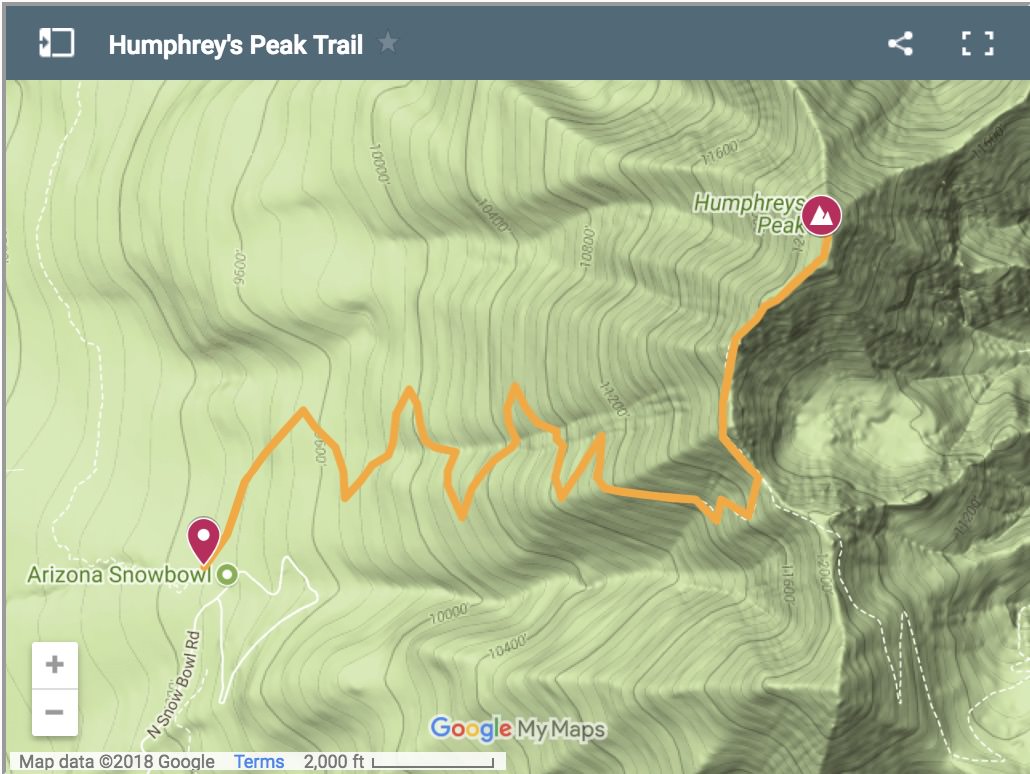






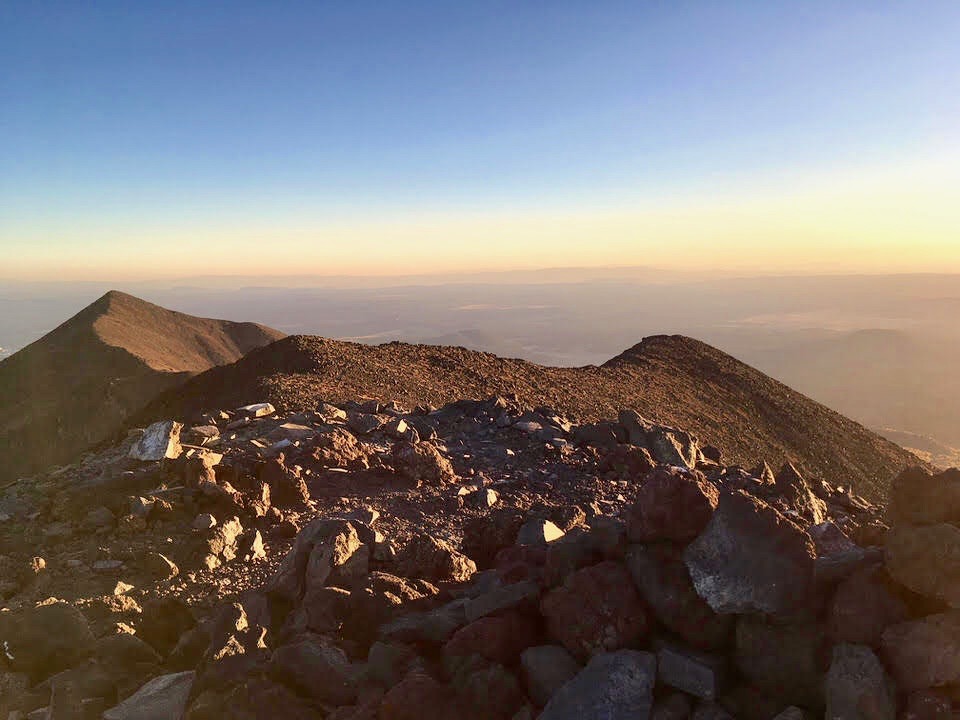


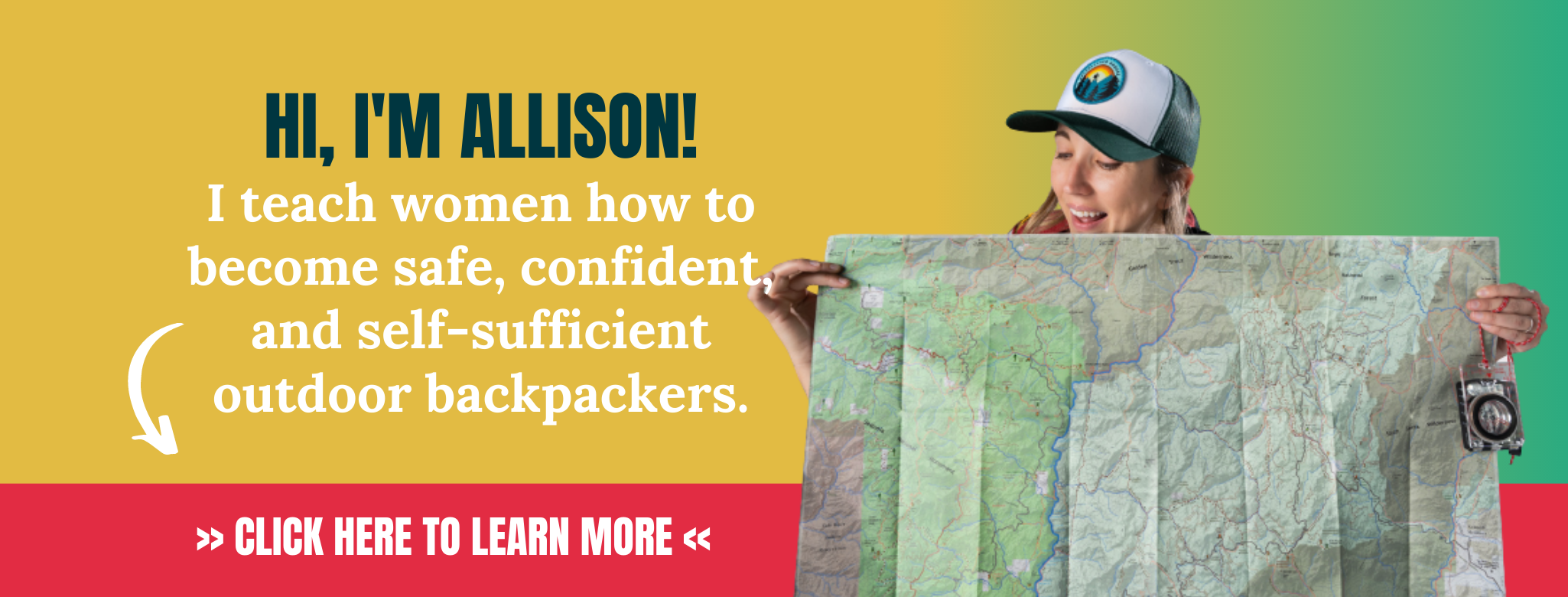


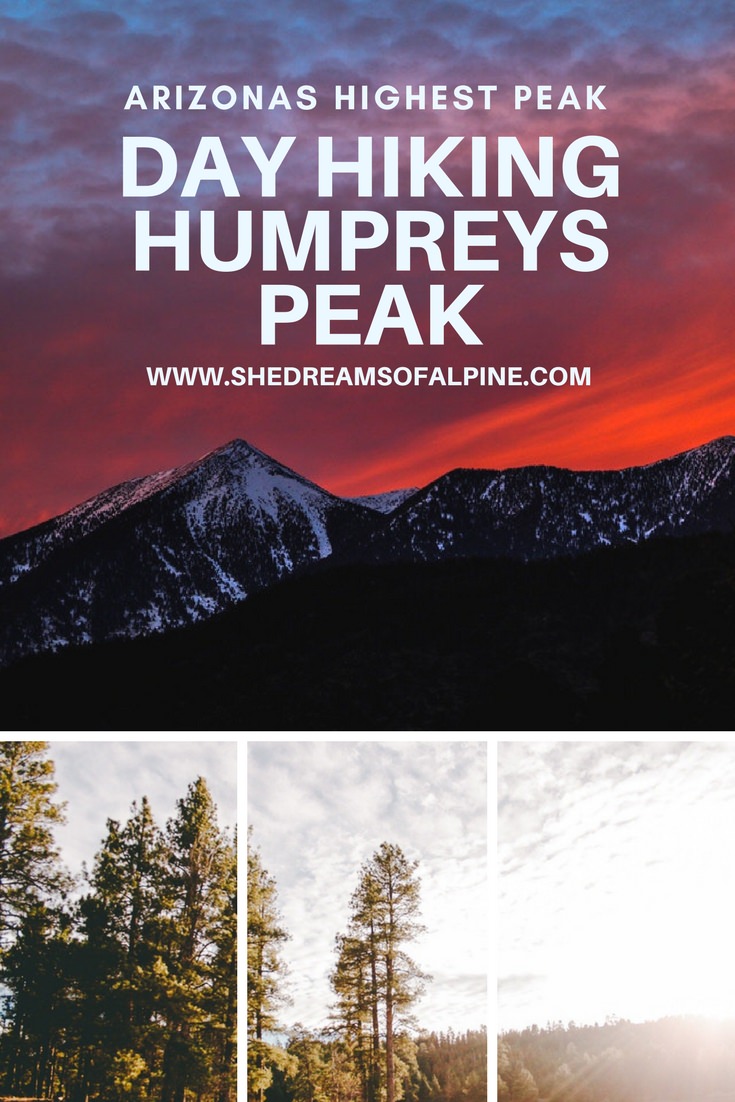
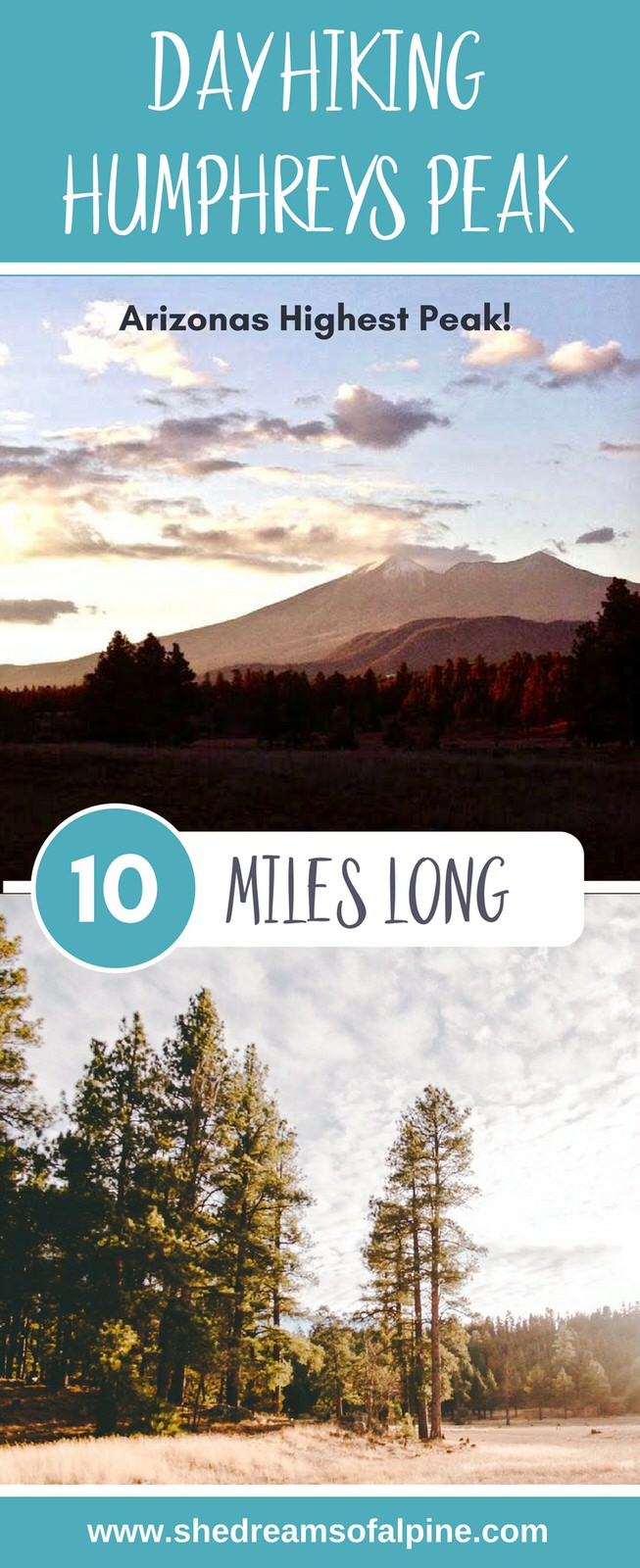

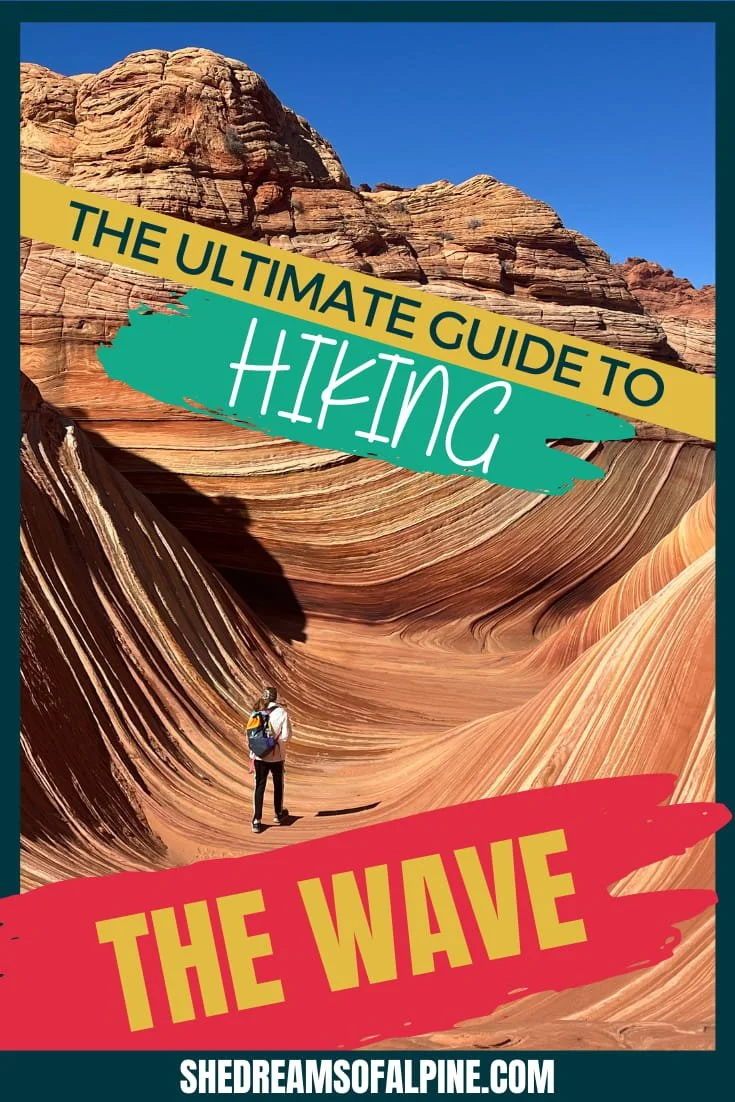
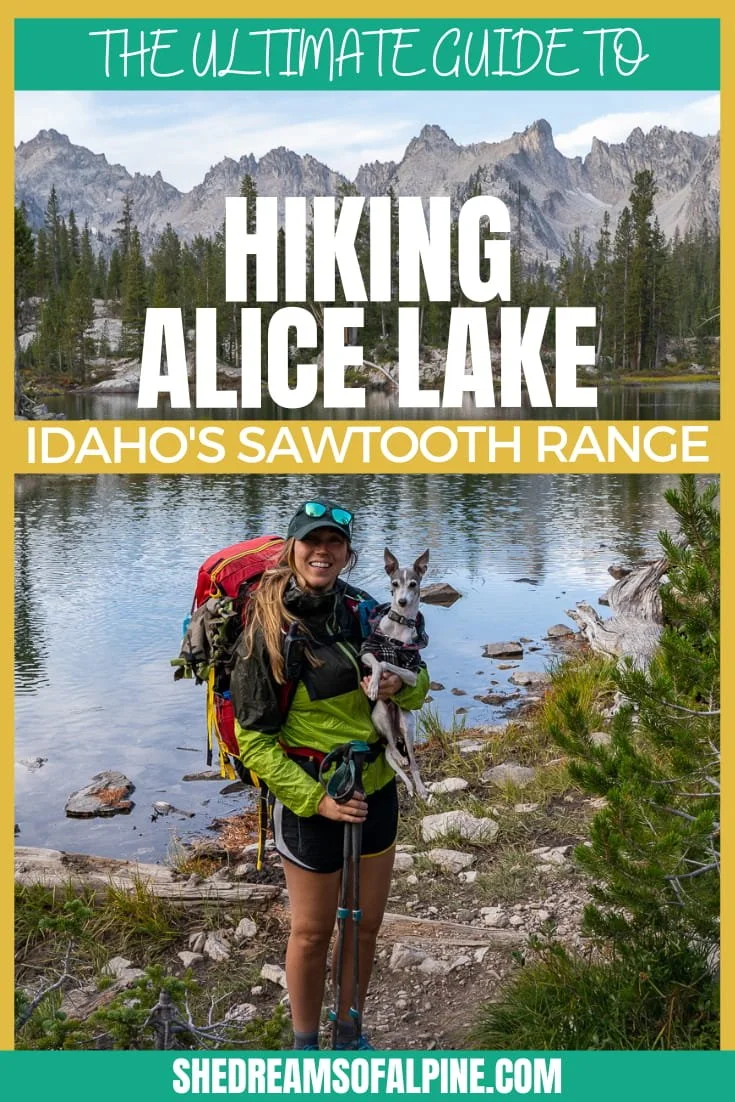
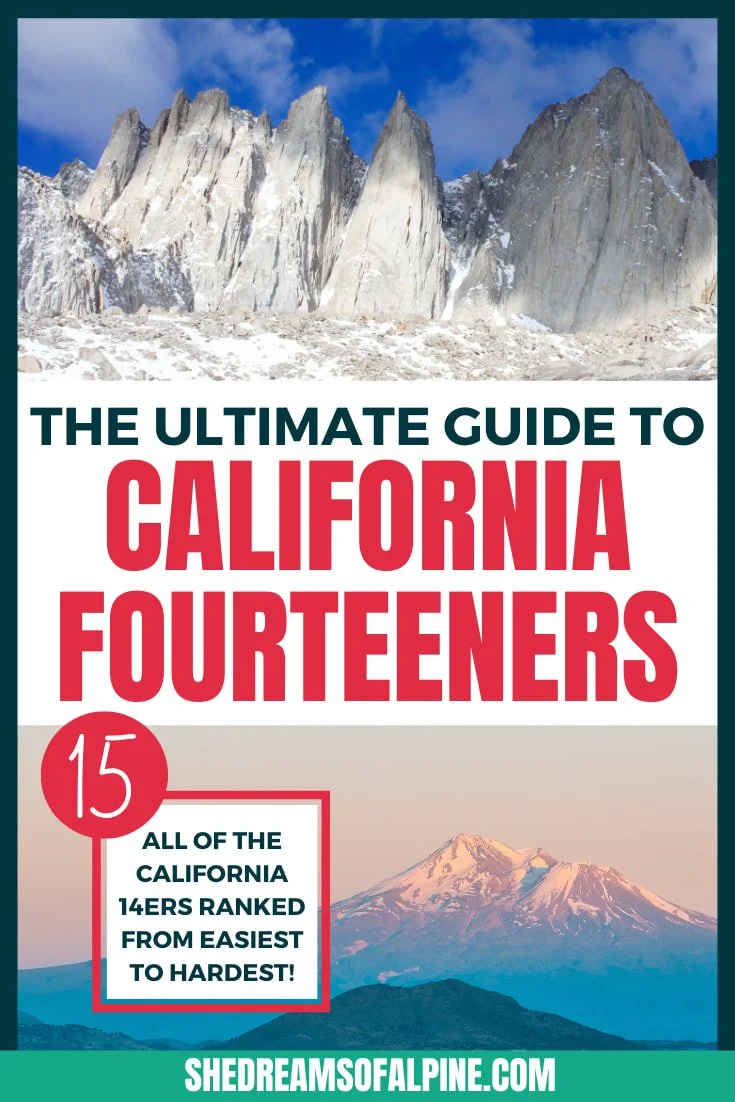




The 13 Best Great Basin National Park Hikes | Hiking in Great Basin National Park might fly under the radar compared to other more famous national parks, but that means you can find solitude and escape the crowds while exploring the ruggedly beautiful landscape. Hiking Great Basin National Park provides a variety of options to challenge yourself to summit a peak or simply go for a stroll among ancient trees. This park is a hidden gem, and hiking is one of the best ways to explore it! | shedreamsofalpine.com